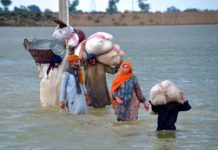Disclaimer: The Eqbal Ahmad Centre for Public Education (EACPE) encourages critical and independent thinking and believes in a free expression of one’s opinion. However, the views expressed in contributed articles are solely those of their respective authors and do not necessarily reflect the position or policy of the EACPE.
Politics in Pakistan operates at four distinct levels: Constituency, Provincial, National and Virtual (media–new and old) space. The dynamics of each level is different from the other levels, which creates structural anomalies with the entire political structure benefiting extra-constitutional forces mainly religious groups and their prime patron, the military and its associated intelligence agencies. Virtual space in the form of media is rolling the three tiers of politics which tends to form a monolithic opinion amongst the urbanized, middle class about the inefficiency of democratic system at national and provincial levels and its discursive forms at local level in the form of ethnic politics. Moreover, at first three levels of operationalization of politics, the casualty is often class struggle along horizontal lines preventing the organization of labourers to participate in the effective, non-violent political struggle against the injustices of the entire political structure.
It is mainly nationalistic impulse out of anti-Indian ideology that our middle class fails to comprehend the dynamics of democracy in Pakistan with military dominance.
At the constituency level, there is an internecine conflict amongst people over caste, party affliction and access to lower levels of bureaucracy which includes thana and katchehry. Here the traditional and relational ties based on primodialism play a vital role in determining the role of political party’s candidates. Traditional political parties usually rely on these sets of preferential politicking to translate it into electoral strength after all only a thug and a politician know that every politics is a local politics. The major beneficiaries of constituency politics are PML-N in Punjab, PPP in Sindh, MQM in Karachi and ANP in KPK. Rules of the games are often trampled over by the considerations of the realistic assessment of need for development of a constituency. Corruption usually grows from the streets of constituency. Classical ties and relational bonds often transcend the limits posed by bureaucratic structure, which has been predicated on legalistic and rationalized scheme of nationhood.
Another remarkable feature of constituency politics is the attempt on the part of democrats to de-bar the impersonal ties of local police and administrative machinery. What at work here often annoys urbanised middle class, who often criticise democrats being illiterate as well as corrupt. However, development at local level is regarded as corruption at national level. It is mainly nationalistic impulse out of anti-Indian ideology that our middle class fails to comprehend the dynamics of democracy in Pakistan with military dominance.
At provincial level, two factors namely ethnicity and class structure are dominant to determine the position of political parties. PMN-N for middle class Punjabis in Punjab, PPP for Sindhis in Sindh, ANP for Pakhtoons in KPK, MQM for migrants (Muhajirs) in Karachi. Parties usually try to protect the rights of their ethnic groups and retain them as their potential electoral vote banks. On class structure line, parties are beneficiaries by default not by any fresh thinking. PTI and PML couched their political idioms for the consumption of middle and upper classes and PPP talks cluelessly about the lower and oppressed class.
The PPP, once a forceful political actor, is now suffering downwards plunge as far as its supposed position as the shadow government is concerned in National Assembly. It is more like a partner than oppositional power. This is mainly due to the PTI’s aggressive attacks on party in power and the PPP simultaneously. PTI’s diatribes against them have brought both the PPP and the government closer to protect the system. The last elections created a bi-polarity in the PPP. In NA it has attained third position in terms of its role and has become an irrelevant force outside Sindh.
This phenomenon is reflected through the PPP’s loss of Punjab to the PML and the PTI — a province which traditionally belonged to the PPP and the PML. Now the PTI has taken its place. The complete loss of Punjab implies the loss of majority of seats in the National Assembly too. It shows that the PPP is losing its power from national politics and becoming a marginalised Sindhi party only. Moreover, at the center of this entire political modus operandi of the PPP lies it’s complete failure to read and understand politically and socially significant changes occurring in Punjab since last one and half decade. These dramatic changes incorporate urbanisation. This untrammelled urbanisation has led to the emergence of crass elitism on the economic front and Deobandisation of large swathe of people on social plank. Both these factors led the PPP to the political blind alley. Unquestionable leadership cult at the cost of the party and patronising way of politics at the expense of policy hurt the PPP in terms of understanding the electoral dynamics of Punjab and other potential electoral parts of the country. Besides these loopholes, there has been an uncanny sense on the part of party leadership about the not-so-brilliant party performance, which has been indulged in corruption and misgovernance. Furthermore, discounting the issues of party organisation and total disregard for a workable policy at grass root level have brought disconnect and mistrust between the leadership and party workers.
In Punjab the PPP has also outsourced its mass mobilization capability to the PTI for which it is now paying heavy price.
At intellectual level, the PPP was a complete failure to provide a progressive alternative to the medievalised religio-political discourse prevalent in the new brave world of the Punjab. The alternative ranges from PPP originally supposed role as a harbinger for the poor and labour community and a poor man’s party. But it did not justify its politics on any of these policy issues. It touted its electoral campaign on obsolete sloganeering of erstwhile and slain leaders. If the trend persists, the PPP will be a history like other parties who did not change according to changing circumstances. However, it is interesting to note that the alternative had emerged in Sindh in the form of Sindhi nationalism that firmly kept the initiative in the hands of the PPP. Even there it was not the PPP, but the influence of other ethnic groups which led to the emergence of Sindhi nationalism. In Punjab the PPP has also outsourced its mass mobilization capability to the PTI for which it is now paying heavy price.
Contributed by Hammad Raza







